Posts Tagged: fumigation
Farm Call: Alternative Fumigant Use and Nutritional Deficiency?
I have an ongoing study with an alternative fumigant (not chloropicrin) compared to an unfumigated control up against the methyl bromide/chloropicrin standard. There's some other stuff in here too, that will be discussed at a later date.
The collaborating grower observed a few weeks ago that plants in the unfumigated control and alternative fumigant were going yellow, in particular the older leaves. That this was not occurring to any sizable degree in the methyl bromide standard was notable.
As many of you my readers know, I really frown upon the identification of leaf yellowing as being caused by this or that deficiency in the absence of any sort of laboratory analysis, so I took two leaf samples from each of the three treatments and submitted them to Perry Labs here in town.
Table 1: Average of two leaf blade samples from unfumigated check, alternative fumigant and methyl bromide standard
| Unfumigated check | Alternative Fumigant | Methyl bromide standard | |
| %N | 2.9 | 2.7 | 3.0 |
| %P | 0.35 | 0.33 | 0.52 |
| %K | 1.2 | 1.15 | 1.34 |
| %Ca | 1.84 | 2.03 | 1.70 |
| %Mg | 0.53 | 0.60 | 0.52 |
| %Na | 0.3 | 0.3 | 0.3 |
| ppm Fe | 134 | 72 | 95 |
| ppm B | 49 | 52 | 54 |
| ppm Zn | 11 | 11 | 11 |
| ppm Cu | 4.4 | 4.1 | 3.6 |
| ppm Mn | 282 | 296 | 304 |
Remembering that two samples per treatment aren't going to give us a what can be called a truly scientific conclusion, these results do at least give us a look at what is going on. First of all, the yellowing probably isn't from nitrogen, which is showing up very much at sufficiency in all treatments. Ditto Ca, Mg and the micros (note that original sample Fe numbers are all over the place); Na is low.
Circling back, we do see that P is lower in both unfumigated and the alternative than the methyl bromide standard, plus the symptoms show up in the older leaves, which checks out for a very mobile element like P. K is just under that recommended from the revised nutrient guidelines from the work I did with Tim Hartz at UC Davis. Additionally, P and K, which come into contact with roots via diffusion in the soil solution (meaning the roots need to grow to the minerals since they are both pretty immobile in the soil) as opposed to mass flow as is the case with nitrate (meaning the nutrient moves to the root since it is mobile), could have their uptake rates reduced by a lessened abundance of roots and root hairs.
The question is then if what we are seeing here is that the lower root growth stemming from less than accustomed fumigation efficacy is also a cause of an apparent deficiency in phosphorous and maybe potassium.
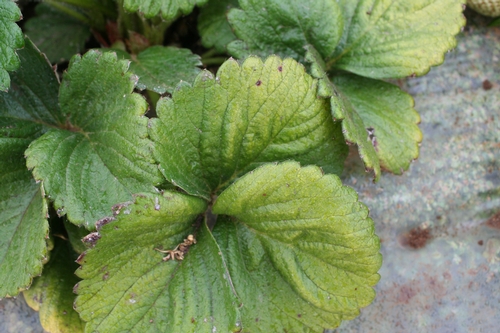
Yellowing of leaves in the alternative fumigant.
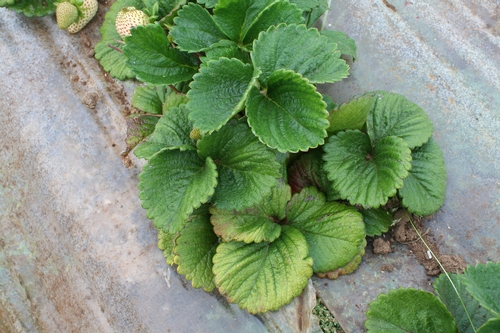
Same thing, yellowing of leaves in the unfumigated control.
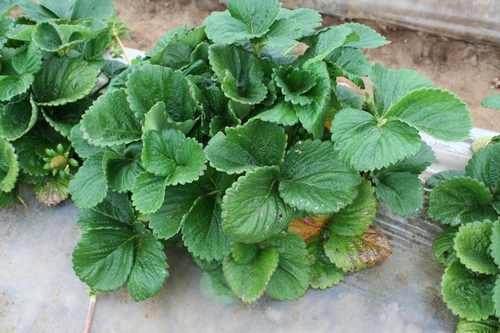
Plants in the methyl bromide/chloropicrin standard; green, lush, productive.
Powerpoint Presentations from Fumigation Alternative Symposium Now Available
Most of the Powerpoint presentations from yesterday's Fumigation Alternative Symposium are now available:
http://ucanr.edu/2013 fumigation alt symposium
Really great meeting by the way, many thanks to the Strawberry Commission for organizing, to each of the presenters for presenting and participants for coming out and being part of it!
A Brief Catalogue of Early Season Transplant Disorders
A few things that growers and field people might being seeing this time of year in strawberry plants.
Salt Toxicity: By far the biggest issue so far in 2012 has been salt damage. This issue is well described in the January 6 post, but a photo is included below for the sake of comparision with the other disorders. To re-iterate, most notable characteristic of salt damage is the burnt margins of the leaves, especially on the more developed leaves. Photo 1 below.
Fumigant Toxicity: Fumigation toxicity is another, fortunately not too common, issue that one will see at this time of year. Every case I have been called out to has involved drip fumigation, and this makes sense, since for several reasons drip fumigants take much longer to exit the soil than shanked in materials like methyl bromide. The process of moving out of the soil was delayed even more in the case depicted below in Photo 2 because of application into the cooler temperatures of late October, 2011. It is notable that, in an attempt to mitigate the fumigant remaining in the beds post fumigation, this field was flushed via the drip tape with a large quantity of water and beds slit several days before planting. Nevertheless, these activities still did not suffice, and the field languishes.
In photo 2 (taken the week of January 9) below, one can see the affected plant is struggling to establish itself and is undersized and yellow. This is probably because its root system was compromised by remaining fumigant (doesn't need to be a lot either, it could have just been a trace) at planting and its root system is still struggling to function normally. While this plant will undoubtedly still survive, it is unlikely to reach full yield potential. The die was cast and its fate determined at the point of planting.
Leaf Blotch Disease: Leaf blotch disease of strawberry normally is found all over Central Coast strawberry fields this time of year. However, since it is dependent on splashing water, it is pretty doubtful that there is much of this disease around this year. Nevertheless, since symptoms superficially mimic those of salt damage it is worth a review.
Generally the lesions of leaf blotch disease consist of tan to gray leaf blotches that commonly, but not always, develop along the margin or edge of the leaflets. The leaf blotches are irregular in shape and are very often surrounded by a purple margin. Affected areas can grow to some size and are able to expand and cover from 1/4 to 1/2 of the leaflet surface. To distinguish leaf blotch disease from salt damage one needs to look for the presence of tiny, brown to black, fungal fruiting bodies in the gray to tan blotches. Photo 3 below.
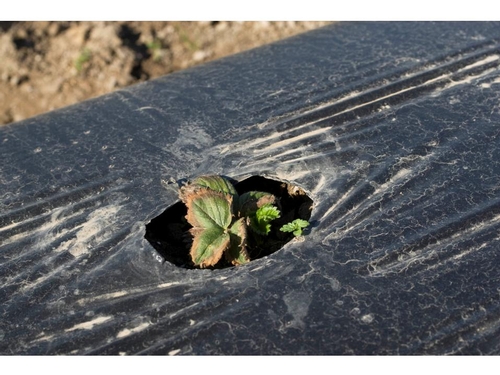
Photo 1: Salt damage- note severity of burning on margins. Courtesy Steven Koike.
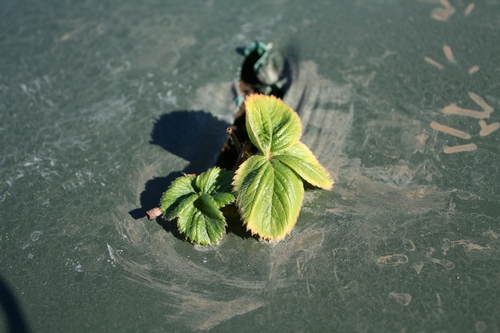
Photo 2: Fumigation toxicity. Plant is weak and not growing well.
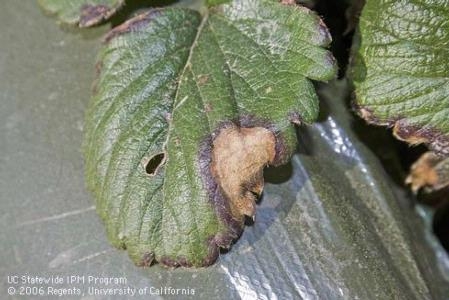
Photo 3: Leaf blotch on strawberry. While superficially similar to margin burning caused by salt, note purple margin as well as rings of growth within the brown blotch.

